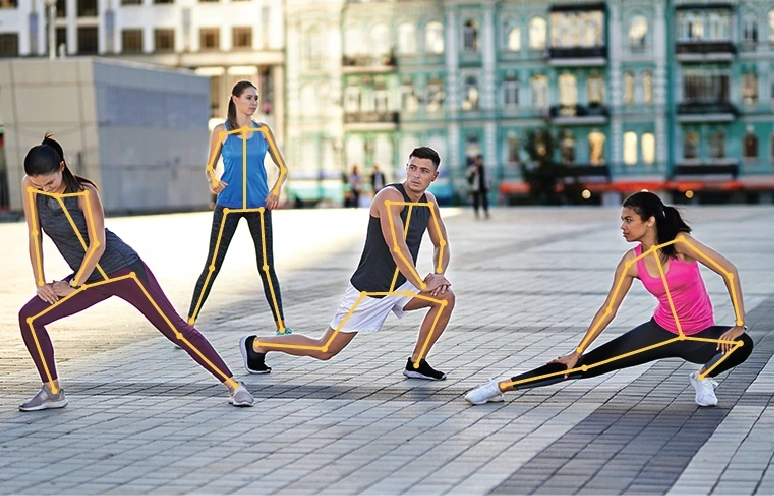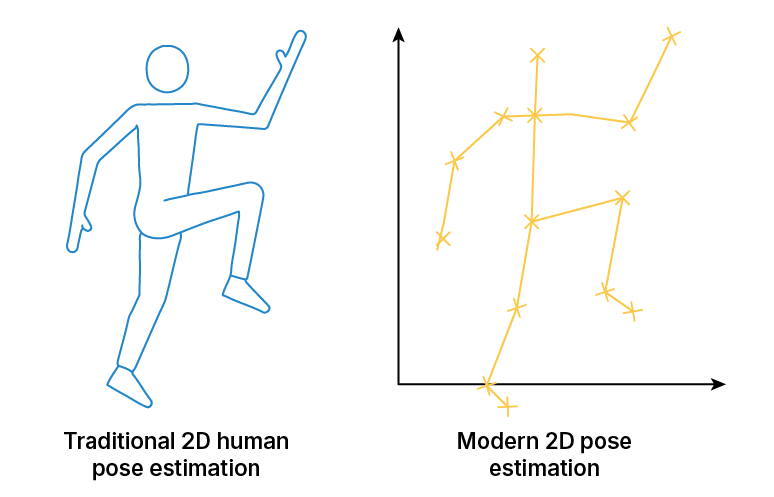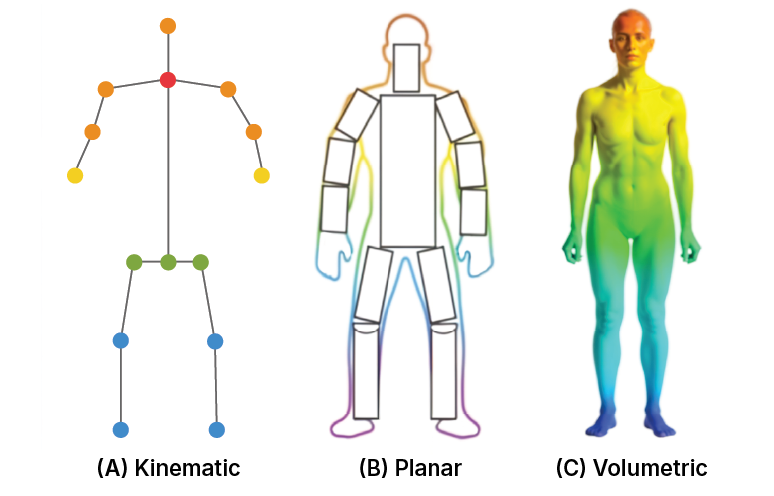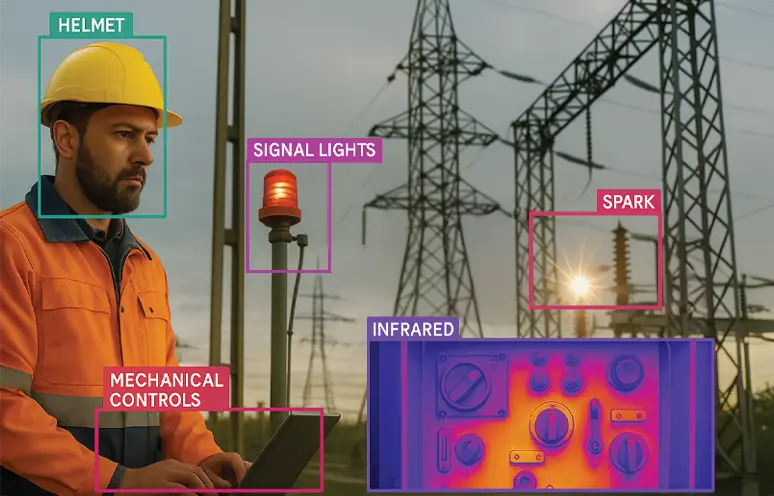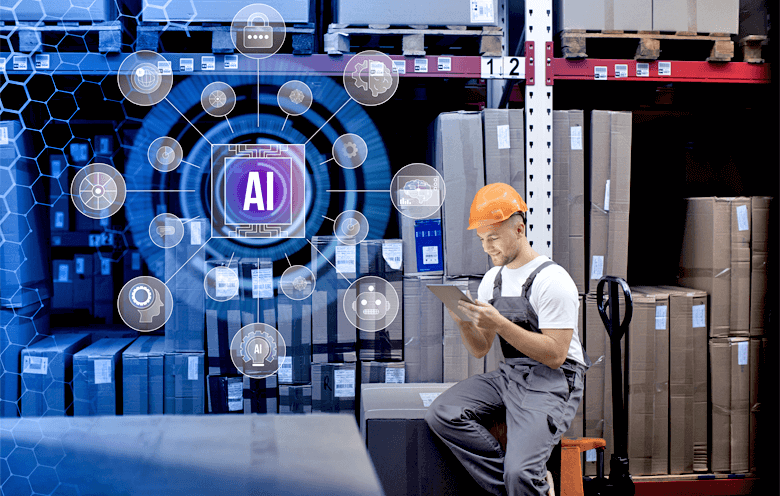Human pose estimation is a method that identifies and classifies joints in the human body using computer vision technology. Artificial intelligence is used to track motion patterns and the positions of human joints and limbs in images and videos.
Pose estimation in computer vision enables machines to interpret and respond accurately to human movements. From automating healthcare diagnostics and supporting advanced surveillance systems to refining athletic performance and enhancing gaming experiences, this technology is used across diverse industries.
In this blog post, we will explore human pose estimation, its importance, challenges, use cases, and future trends.
What is human pose estimation?
Human pose estimation is a computer vision task that uses trained models to identify semantic key points. These key points can be joints and limbs that shape the pose of a person in real-time. With pose estimations, you can analyze the key points through motions and make decisions based on the input.
Computer vision technology is used to process highly complex images and videos that imitate the process of the human mind. This technology is applied to tasks like body motion detection, posture correction applications, AI fitness coaching, and exercise supervision.
There are three common types of human models: skeleton-based, contour-based, and volume-based models. The skeleton-based model is currently the most commonly used one in human pose estimation because of its flexibility.
Why is pose estimation important?
Human pose estimation goes beyond recognizing movement – it offers valuable insights into health, performance, and interaction. It powers smarter decisions and safer, more personalized experiences.
-
Accurate movement analysis
Pose estimation can track patient movement and provide data to the therapist to assess the progress in the patient’s health and modify the treatment. It identifies health issues like neurological disorders and mobility problems, offering timely intervention and personalized care.
-
Performance analysis
In sports, pose estimation analyzes athletes’ body movements, helping coaches identify areas of improvement and modify training strategies. It also tracks the risk of injury during training sessions, allowing for adjustments in postures.
-
Human-Computer Interaction (HCI)
Pose estimation helps users to communicate with applications through natural body movement, providing control in gaming and virtual movement. It is a powerful tool that allows individuals with disabilities to interact with technology.
-
Surveillance and security
Pose estimation detects unusual behavior, monitors human activity, and enhances security systems. It also enables robots to learn and mimic human movements to assist with surgery or manufacturing processes. Moreover, it enhances augmented reality in retail and shopping applications.
Bottom-up vs. top-down methods
These two core approaches that define how human pose estimation systems detect and assemble key points. Understanding their differences helps you choose the right method for your specific application.
| Feature | Top-down method | Bottom-up method |
|---|---|---|
| Detection Order | Detects each person first, then estimates pose | Detects all key points first, then groups into poses |
| Computational Cost | Increases with number of people; slower on crowded images | More stable; processes entire image at once |
| Performance in Crowds | Struggles with occlusions and overlapping people | Handles crowded scenes better by separating key points afterward |
| Accuracy | Often achieves higher accuracy per individual | Slightly lower accuracy due to key point association challenges |
| Speed in Multi-Person Scenes | Slower, as pose estimation is repeated per person | Faster, especially with many people |
| Ideal Use Cases | Fitness apps, sports analytics, single-person tracking | Surveillance, crowd analysis, real-time multi-person tracking |
| Examples of Models | Mask R-CNN, HRNet (top-down versions) | OpenPose, Higher HRNet, Associative Embedding |
What is 2d human pose estimation?
2D human pose estimation identifies human position in spatial location or 2D position by tracking the key points on the body from visuals such as videos and images. Traditional 2D estimation methods used hand-crafted features and extraction methods to identify human body parts. Early methods used to track humans as stick figures to achieve posture structure.
Modern machine learning models use a pose estimation deep learning approach that identifies key points from the human body and represents them in 2D coordinates as X and Y. The four main types of 2D pose estimation popularly used are OpenPose, CPN, AlphaPose, and HRNet.
What is 3d human pose estimation?
3D human pose estimation is a method that is used to track the joints in the human body in 3D space. Since it provides extensive information on the human body in 3D structure, it has attracted much interest in recent years. It is widely used in 3D animation industries and virtual reality.
The pose estimation process starts with capturing and analyzing data in each frame and detecting key points on the human body. Models first work on 2D coordinates, as it is easy and quick to extract data and interpret it into 3D space. Extracting 3D pose estimation is divided into two arts, which include:
- Detecting and extracting 2D key points from the images. Horizontal and vertical coordinates are used to build a skeleton structure.
- Converting the 2d coordinates into 3D by adding the depth and dimensions.
What is 3D human body modelling?
Human body modelling is a vital aspect of human pose estimation as it represents the features and key points extracted from the visual data. A model-based approach is used to describe human body pose and offer 2D and 3D poses. Most methods use an N-joint rigid kinematic model where a human body is represented with joints and limbs, containing body kinematic structure and body shape information. There are three types of human body modelling.
-
Kinematic model
The kinematic model is also called a skeleton-based model, which includes a set of joint positions and limb orientations relative to the human body structure. This model is also known as the tree structure model. It captures the relation between different body parts. The kinematic model is useful for flexible graph representation but is limited in representing texture and shape information.
-
Planar model
The planar model, also called the contour-based model, is mainly used in 2D pose estimation. In this model, the body posture is represented by rectangles showing the human body as body contours. Traditionally, cardboard models were used to represent the limbs of a person in rectangular shapes. Active Shape Model (ASM) is presently used to capture the full body graph and the silhouette deformations using principal component analysis.
-
Volumetric model
A volumetric model is widely used in 3D pose estimation. This model represents the human body in a 3D structure using shapes like cones and cylinders to outline human pose in a realistic form. This model is often used in deep learning methods to train on a high-resolution dataset for full-body scans.
Human pose estimation with deep learning
The rapid development of pose estimation deep learning has significantly enhanced image segmentation and object detection process. Pose estimation is easily applicable through computer vision, so you can build a custom pose estimator using existing models. Some popular architectures to help you get started include:
-
OpenPose
OpenPose is a popular bottom-up framework for real-time, multi-person pose estimation, offering high-accuracy body, hand, foot, and face key point detection on diverse hardware from CPUs to GPUs, ideal even for edge devices and embedded CCTV systems.
-
HRNet
High-Resolution Net (HRNet) is a neural network for human pose estimation used for image processing problems and maintains high-resolution representations when estimating postures in televised sports.
-
DeepCut
This is another popular bottom-up approach for multi-person human pose estimation. It detects the number of people in an image and then predicts the joint locations, mainly applied to process football and basketball videos.
-
AlphaPose
AlphaPose is a popular top-down method of pose estimation useful for inaccurate human bounding boxes. It is applicable for detecting both single and multi-person poses in images or video fields.
-
DeepPose
DeepPose is a human pose estimator used in deep neural networks to capture all joints, hinges a pooling layer, a convolution layer, and a fully connected layer to form part of these layers.
-
PoseNet
This is a pose estimator architecture built on TensorFlow.js to run on mobile devices and browsers. It can be used to estimate a single pose or multiple poses.
-
DensePose
This pose estimation technique maps all human pixels of an RGB image to the 3D surface of the human body and can be used for single and multiple-pose estimation problems.
-
TensorFlow
TensorFlow Lite is used for pose estimation in a lightweight ML model for low-power edge devices.
-
OpenPifPaf
OpenPifPaf is an open-source computer vision library built on top of the PyTorch deep learning framework for pose understanding and movement tracking scenarios, such as occlusion and cluttered backgrounds.
-
YOLOv8
These YOLOv8 pose models use the -pose suffix and are trained on the COCO key points dataset and are suitable for a variety of pose estimation tasks.
Main challenges of human pose estimation
Human pose estimation faces hurdles like occlusions, diverse poses, and the need for real-time accuracy. Overcoming these challenges is key to building robust, scalable solutions across industries.
Overlapping bodies: When the view of a body part is hidden by other people, objects, or the body itself, it becomes challenging for algorithms to precisely estimate the pose.
Solution: The bottom-up method is used in crowded places as it correctly groups the key points and estimates the body pose.
Variations in appearance: Humans have varying body shapes that are viewed from different angles and camera perspectives, which can complicate the performance of pose estimation models. Changes in weather conditions can add to the complexities.
Solutions: Training the models on various datasets and providing a multi-view approach can enhance the pose estimation performance.
Real-time performance: Developing a pose estimation model that performs in real-time for applications like AR/VR, fitness tracking, and human-computer interaction is a major challenge. Particularly with complex scenes and high accuracy requirements.
Solutions: Using lightweight ML models or mobile applications and web browsers can improve the real-time performance.
Top 5 use cases and applications for human pose estimation
Pose estimation is an advanced technology that helps organizations track human movements in real-time. Its wide application in fields like fitness, rehabilitation, animation, gaming, robotics, and even surveillance has brought tremendous gains. Let’s learn.
-
Fitness training applications
Human pose estimation has been widely used in the context of AI fitness applications. It analyses the body movements of athletes in different scenarios using a smartphone camera. These applications provide athletes with insights on how they perform a certain movement and can show accurate metrics for exercises. They can lever angle in power movements, changes in technique between repetitions. HPE methods are used to track if a user is performing the exercise correctly technique-wise and provide recommendations such as posture correction and biomechanical tips.
-
Physiotherapy and rehabilitation applications
The rehabilitation application needs much more accuracy in detecting key points than a fitness application. It is vital to monitor key points and how they change during the movement to avoid injuries. Pose estimation monitors performance of a squat, checking for knee caving or rounded backs, and provides feedback to correct them. Moreover, therapists can track movement patterns and identify issues like postural imbalance that indicate medical conditions, prompting earlier diagnosis and personalized treatment plans.
-
Virtual shopping applications
Pose estimation integrated into augmented reality-based applications like virtual fitting rooms can detect and recognize the position of a human body in space. Shoppers can test the size of the clothes before buying. Pose estimation tracks the key points on the human body and transfers the data to an augmented reality model that will fit clothes on the user.
-
Animation and gaming applications
Game development is a complex task that requires knowledge of human body mechanics. Thus, pose estimation is widely used in gaming animations to streamline the process by transferring key points data in a certain position to the animated model. Further, the key points resemble motion tracking technology used in video production.
-
Surveillance and tracking human activity
By analyzing the sequence of poses and movements, pose estimation can be used to identify and categorize human actions, such as walking, running, sitting, or specific gestures. Pose estimation analyzes the sequence of movements to identify and categories human actions and specific gesture. Amazon GO, a cashier-less store, applies human pose estimation to track whether a person took an item from a shelf. Pose estimation in computer vision allows Amazon to automate the checkout in its stores using a network of camera sensors and IoT devices. In this case, the pose estimation model analyzes the key points of the customers’ hands and heads to identify if they took the product from the shelf or left it in place.
Future trends
Organizations from all industries are planning to invest in technology that enhances performance and safety. Human pose estimation can help them achieve this goal by analyzing how workers interact with the environment in the manufacturing process, identifying safety lifting techniques in warehouses, and studying athletes’ movements in sports. In such industries, pose estimation enables professionals to rely on data driven motion to guide training and prevent injuries. With the evolution in technology these systems won’t just detect improper position; they will proactively alert the user in real-time, suggesting corrective actions before risk increases.
The study achieved 92.8% accuracy in recognizing assembly actions using YOLOv3 and 82.1% accuracy in estimating repetitive assembly operating times through joint coordinate extraction. (Source: PubMed Central: National Library of Medicine)
Drive innovation and insight with human pose estimation.
Human pose estimation is transforming the way the surveillance and fitness industry is tracking human movements. Physical performance and workplace safety challenges are only growing more complex. By reducing the risk of workplace accident and enhancing performance organizations can now protect their workforce and increase retention rate. Adopting pose estimation turns data driven insights into measurable advantages and foster resilience. Whether preventing workplace injuries, improving patient rehabilitation, or refining athletic techniques partnering with a skilled technology provider is essential. With the right expertise, businesses can confidently integrate pose estimation solutions that drive measurable improvements, safeguard their teams, and stay ahead in a data-driven world.
FAQs
1. What is the primary goal of pose estimation in computer vision?
The primary goal of pose estimation in computer vision is to identify and map key points on the human body, like joints and limbs, to understand its position and movement. This enables machines to interpret complex human activities from images or video. Ultimately, it bridges the gap between visual data and meaningful human action recognition.
2. Why is pose estimation important?
Pose estimation is important because it enables machines to understand and interpret human movements, opening doors to applications like activity recognition, fitness tracking, and human-computer interaction. It enhances safety, automation, and personalized experiences across industries from healthcare to retail. By turning complex body motions into precise data, pose estimation helps businesses make smarter, real-time decisions.
3. What are the results of pose estimation?
The results of pose estimation are precise coordinates of key body joints, typically represented as (x, y) points on an image or video frame. These key points allow you to reconstruct the human skeleton, analyze movements, and track posture or gestures over time. This data fuels applications like activity recognition, fitness tracking, real-time animation, and even safety monitoring in workplaces.
